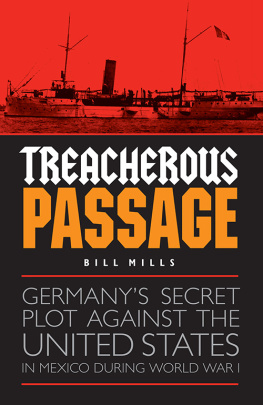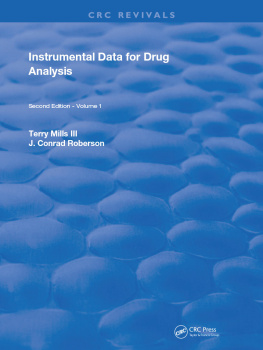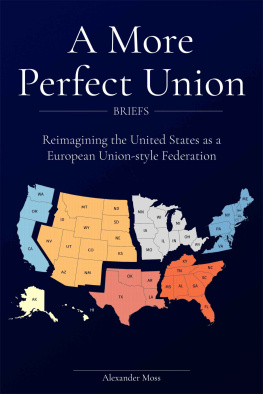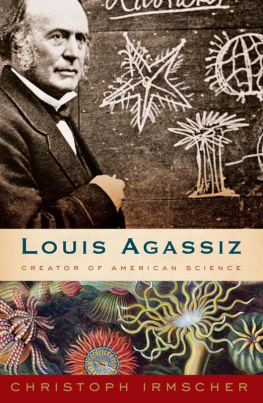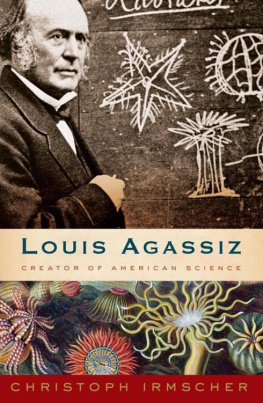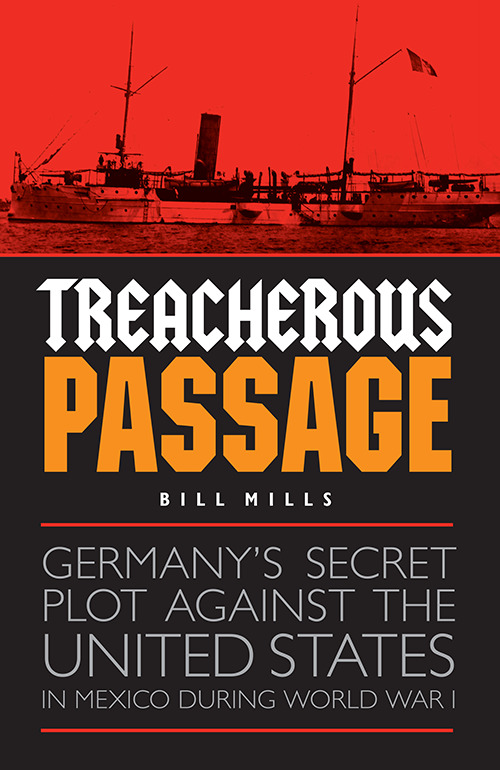2017 by William B. Mills
Cover designed by University of Nebraska Press; cover image is from the interior.
All rights reserved. Potomac Books is an imprint of the University of Nebraska Press.
Names: Mills, Bill, 1958 author.
Title: Treacherous passage: Germanys secret plot against the United States in Mexico during World War I / Bill Mills.
Description: Lincoln: Potomac Books, an imprint of the University of Nebraska Press, 2016. | Includes bibliographical references and index.
Identifiers: LCCN 2016010733 | ISBN 9781612348544 (cloth: alk. paper) | ISBN 9781612348735 (epub) | ISBN 9781612348742 (mobi) | ISBN 9781612348759 (pdf )
Subjects: LCSH : World War, 19141918Diplomatic history. | MexicoForeign relationsGermany. | GermanyForeign relationsMexico. | World War, 19141918United States.
Classification: LCC D 619.3 . M 56 2016 | DDC 940.4/87430972dc23 LC record available at https://lccn.loc.gov/2016010733
The publisher does not have any control over and does not assume any responsibility for author or third-party websites or their content.
This book had an unusual inception. While researching my previous work, The League, a history of the American Protective Leaguethe Justice Departments volunteer detective force during World War I, I came across a thrilling account about a German raider called the Alexander Agassiz that was captured by a U.S. Navy gunboat off the coast of Mexico. According to the writer, the Agassiz was seized as the result of a conversation overheard by an undercover operative in a San Diego restaurant.
Years later, while searching through the records of the U.S. National Archives, I discovered that this period account of the Alexander Agassiz affair was fiction, either invented by the author or the result of reliance on inaccurate records. Delving deeper into the background of the episode I found truth more amazing than fiction, a tale of soldiers of fortune training a German Mexican army to invade the United States, sunken warships reclaimed from the sea for battle, a formidable German trading house dedicated to profit and subversion, heroes and turncoats, drama on the high seas and in high court. The more that I learned about this forgotten true-life adventure, the more fascinated I became, and soon began writing the manuscript that developed into Treacherous Passage.
Many talented individuals assisted in gathering the material for this book. Researcher-translator Manuel Osuna was invaluable in tracking down records in Mazatln, Mexico, and providing Spanish translation. Manuel is an uncompromising and determined researcher. When a key publication from the 1920s was discovered missing at a city archive, Manuel tracked down a college professor who had a photocopy of the document and sent me a copy of the photocopy! Heather Smedberg in Special Collections & Archives at the UC San Diego Library located extensive documentation on the early history of the Alexander Agassiz and the Marine Biological Station in the Scripps Institution of Oceanography Archives. Annegret Wilke of Politisches Archiv des Auswrtigen Amts (Political Archive of the German Foreign Office in Berlin) gave generously of her time to locate German government records related to Fritz Ungers appointment as honorary consul in Mazatln. Rebecca Livingston did an outstanding and exhaustive job combing through State Department and Military Intelligence records on Dr. Paul Bernardo Altendorf held in the National Archives at College Park Maryland. Archivist Jennifer Albin was extremely helpful in locating the complete court records of the Alexander Agassiz Prize Court Trial at the National Archives at Riverside, California.
I am also very thankful for the support and guidance of my exceptional agent, Anne Devlin, and for the enthusiasm and editorial skill of Tom Swanson and the aid of Emily Wendell at Potomac Books, University of Nebraska Press.
For the assistance provided by all of these individuals I remain deeply grateful.
The Morelos Will Be Ours
the federal gunboat Tampico began over love for a woman. It was said that twenty-four-year-old Lieutenant Hilario Malpica, the ships executive officer, had fallen for a brown-eyed beauty whose family was devoted to the Constitutionalist cause. For weeks, Malpica had secretly plotted to take over the Mexican warship for the Constitutionalist rebel forces. His opportunity came on the night of February 22, 1914, when half the ships company had been granted shore leave to celebrate the Carnival at Guaymas. Aided by Rabatet, the paymaster, and engineering officers Estrada and Johnson, Malpica took charge of the remaining crew members, then boldly informed Captain Castellanos and Chief Engineer Smith that their ship was under mutiny, and invited them to join the rebel forces. The invitation was rejected out of hand.
If you make no resistance you will not be harmed, Malpica told them evenly, and at the first opportunity you will be handed over to the federal government.
His former superiors acquiesced, and the rebels gained their first naval gunboat without a struggle. Now fully in command, Malpica gave orders to set course for Topolobampo on the Gulf of California in northwestern Mexico, a port that had recently been captured by the Constitutionalists.
truly devastating. Unfortunately for the mutineers, however, the Tampicos steering gear broke down in the effort and she was forced to turn away, continuing on course to Topolobampo.
from the state of Chiapas, Belisario Domnguez, gave a public speech denouncing Huerta as a tyrant, Domnguez was brutally murdered, his bullet-ridden body found weeks later in a roadside ditch. In the Mexican congress, Huerta was harshly castigated for the crime. In retaliation, Huerta dissolved the congress and ordered 110 congressmen to be arrested and hauled off to prison. Despite these repressive actions, Huertas military dictatorship had the support of powerful factions in Mexico, including the hacendados, large landowners who wanted to retain their vast landholdings from populist confiscation, the Mexican Army, and initially, the church.
Outside Mexico City, opposition grew quickly against President Huerta, El Usurpador, the usurper who had murdered Madero. The governor of the state of Coahuila, tall and dignified former senator Venustiano Carranza, demanded the immediate ouster of Huerta and restoration of the Constitution of 1857, which had guaranteed Mexican citizens freedom of speech, freedom of the press, and freedom of assembly. Carranza proclaimed himself Primer Jefe (First Chief ) of the Constitutionalists, and named Alvaro Obregn, a rancher from Sonora, as commander in chief of a Constitutionalist army in the northwest. Obregn proved an able organizer and military strategist, raising a powerful army that captured one federal town after another. Also allied with Carranza in the north was bandit-turned-revolutionary Pancho Villa, who transformed a ragtag group of disaffected workers from rural mining camps, haciendas, and villages into a sizable army that pursued Huertas forces like a desert horde. In southern Mexico, Emiliano Zapata, who for years had been leading a campesino revolt against the hacendados who had stolen their land, similarly turned his followers against the Huerta government. By early 1914, less than a year after Huerta had assumed power, over 70 percent of Mexican territory was controlled by the Constitutionalist forces. Now with the mutiny on the

